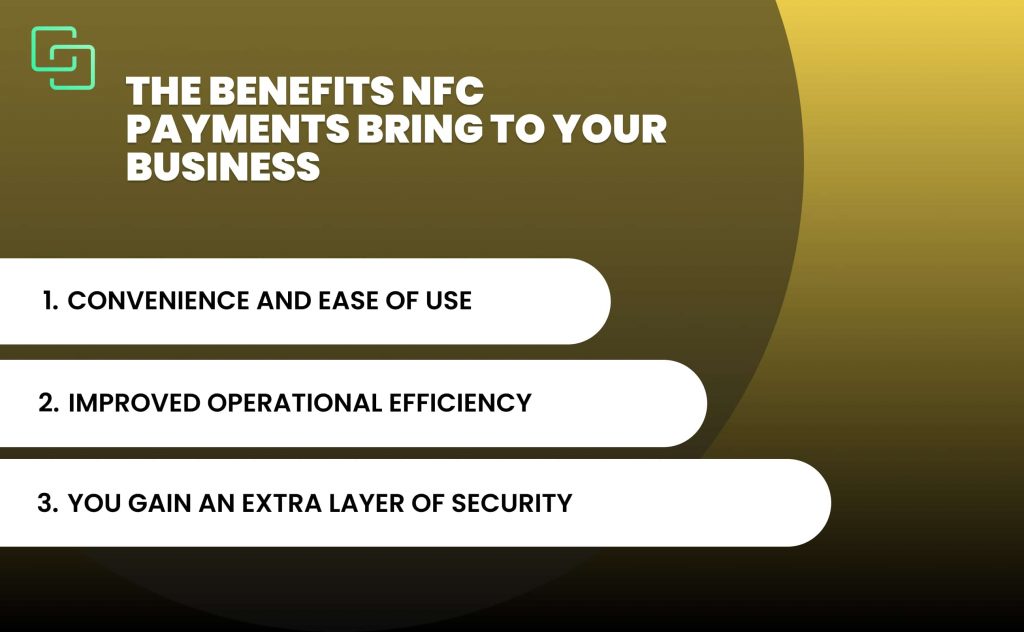What are NFC payments and how do they work?

Franco Brutti
A few years ago, paying in cash was standard, until bank transfers came along. Then, over the years, digital payment platforms like PayPal came along to enjoy fast payments on some platforms. Nowadays, the latest development is NFC, a fast and effective means of payment that can make it easier for your customers.
What are NFC payments?
In today's world, there are countless ways to complete a transaction.
If your business is not yet using near-field communication (NFC) payments, you may be curious about what they entail and how you could use this new technology.
NFC payments are a form of contactless payment that uses near-field communication, as the name implies. NFC transfers data wirelessly through a cell phone, laptop, tablet, or other device by sharing it with another device.
This technology is behind contactless payments through an option called mobile payment, which some companies have incorporated into their services such as Apple Pay, Samsung Pay, Google Pay, and contactless cards.
Cell phones that allow users to pay in this way are equipped with NFC technology.
That is, a consumer can pay using options such as those mentioned above, but not all cell phones are equipped with NFC technology, especially if they are older models.
How does NFC payment technology work?
NFC payment technology works on a chip that contains a specific RFID radio frequency.
When two chips are close together, they can create a contactless connection between devices. This allows the transfer of information, including the data needed to complete a transaction.
The 3 methods of operation
There are 3 ways to use NFC technology, but each of them is according to the platform and/or company you choose to work with.
Card emulation: this mode allows monetary transactions.
Reader-Writer: this mode allows the user to interact with the tags.
Peer-to-peer: this mode allows two NFC devices to exchange data.
The benefits NFC payments bring to your business
There are numerous advantages for both businesses and consumers using NFC technology for payments:
1. Convenience and ease of use
Consumer expectations for convenience are ever-increasing. In almost any situation, consumers tend to flock to the quickest, easiest, and most convenient option. After all, saving time is important.
An NFC POS-enabled NFC reader facilitates payment transactions, as consumers often only need to show their phones or NFC cards to make a payment.
Unlike EMV transactions, where consumers had to learn to dive in and wait, NFC mobile payments are often simple and intuitive.
What's the one item your customers always have on them at all times? Their cell phone, of course. It's no wonder that mobile wallets using near-field communication are increasing in popularity.
For those who still prefer cards, NFC-enabled cards provide the same functionality in a convenient and familiar package, but with the security of NFC payment technology.
2. Improved operational efficiency
NFC enables faster payment transactions, which reduces the amount of time customers have to wait in line, as well as the time they spend at the cash register.
In other words, NFC payments help speed up checkout lines, which increases customer satisfaction with your business. Also, they mean less time per transaction. And you see critical operational efficiencies for businesses with a high volume of transactions at the time of payment.
Happier customers and more efficient operations are measured in the bottom line of businesses around the world. The best part is that this technology is easy to implement.
You'll only need NFC-enabled payment terminals, such as credit card terminals.
Luckily, most new or sold payment acceptance equipment already contains near-field communication payment technology. The setup is simple and quick.
3. You acquire a layer of security
If you're wondering about the security of NFC payment technology, it's understandable.
Maintaining customer confidence depends on providing secure transmission of your payments and any data related to payment transactions.
NFC signals only transmit data inches away from the NFC device or payment terminal. Unlike wireless Internet technology, near-field communication signals cannot be hacked from across town, across the street, or even across the room.
The security protections offered by cell phones make NFC contactless payments even more secure.
In addition to protection against tokenization of private and personally identifiable data, smartphones add an additional layer of authentication, such as passwords and biometric security.
This additional security is layered on top of existing fraud filters and other security measures such as EMV that help protect all electronic payment transactions.

The security of NFC payments
The security layer of NFC payments is high, thanks to the security features already included in the devices that implement this technology. If you consider that it must be located near another NFC device and authorized by the user to complete a transaction, it is unlikely to be scammed.
Also, with NFC mobile payments, card numbers are no longer used, as they are replaced by "payment tokens". But let's look at some of the security features of NFC payments:
1. Proximity protection
Contactless payment solutions work over shorter distances than you can imagine, so at all times, you would witness the entire process of enabling, processing, and completing the payment via the NFC method.
For a potential thief to steal information, he or she would have to be too close to an NFC-enabled device. This proximity protection represents the first level of defense.
2. User initiation
To begin each transaction, the customer must initiate the payment process. It usually requires launching the appropriate NFC application within the phone to establish a connection between the device and the merchant's reader.
If a thief gets close enough, no transactions can be made in standby mode.
What's more, with some NFC applications, the user must also verify a transaction by using two-factor authentication, such as fingerprint scanning technology or a private passcode.
3. Secure element validation
Once a connection has been established, the transaction is only completed after the card or mobile device has validated the purchase using a secure element chip.
The validation process assigns a unique digital signature to each payment rather than transferring credit or debit card numbers between the device and the reader.
Secure element verification is similar to the validation process associated with chip-based EMV credit cards.
How can your customers pay with NFC?
If you are interested in knowing how your customers could make payments, the truth is that they have 2 options:
Card to make payments: the customer uses a card containing NFC technology to transfer payment information to make a purchase. The customer places a card near the payment terminal that is NFC-enabled.
Mobile devices as a card: Mobile phones and other devices use applications that contain payment information. This means that a payment can be made using a mobile device.
Kevin's point-of-safe-solution technology is the first of its kind, allowing businesses to use their existing POS device to take advantage of account-to-account (A2A) payments.
That is, customers can pay directly in-store using NFC technology on their mobile device, eliminating the need for bank cards and their associated fees and lengthy processing times.
How can merchants accept NFC payments?
If a business wants to start accepting NFC payments, it will need to obtain the necessary equipment. Here we have to include an NFC-enabled reader, plus they need to work with a payment infrastructure that can accept this form of payment.
Once they are in place, all the customer has to do is place their cell phone next to the reader and the transaction can be completed, giving a number of distinct advantages:
Accepting NFC payments is easy and convenient
Security, stability, and protection for both customers and the company.
Offering payment with your smartphone, a device that everyone carries with them.
Keeping up to date with new payment trends, as NFC could be the future of payment management.
Cost-effectiveness as NFC payment equipment is priced right for small businesses.
How to activate NFC to pay with your cell phone?
Now that you know how attractive NFC technology is, you may want to know if you can take advantage of this payment method on your mobile. There are several ways to check.
NFC on Android
Go to the settings panel from the top of the screen.
You will see the options to enable and disable the WiFi network. If the NFC icon appears here, you have this technology.
You may not have it in that options window, so going to "Settings" and typing "NFC" in the search bar is another method to find out if you have such technology.
You can also check the device's box or check the features tab.
NFC on iOS
Every iPhone 6 or higher model has a built-in NFC chip.
A brief history of NFC
NFC technology was developed by the Sony and Philips companies in the early 2000s. It’s based on Radio Frequency Identification (RFID), which is a similar technology that has been in use for some time using radio waves.
However, the first use of NFC for contactless payments was in 1997, 3 years before its development as such. Back then, Speedpass could be used to pay for gas at Mobil gas stations via a key fob.
So far, it has only continued to evolve to include payment cards, key fobs, stickers, smartphones and tags. Its popularity can be attributed to the fact that it eliminates the hassle of swiping or texting to make payments while still offering a high degree of security as we have seen so far.
Are you ready to start using NFC payment technology yet?
Without a doubt, this technology seems like it will be standard in a few years, so you better start getting familiar with it, after all, it does nothing but offer advantages and benefits for the 2 parties involved: company and consumer.
Tell us, does your device have NFC technology, and if so, did you know about it? But wait, we have a better question, in case you do, are you ready to start using it?
Feel free to answer all these questions below in the comments, we'll be happy to read you.
Looking for something specific?
9 feb 2024
14 nov 2023
7 nov 2023
5 oct 2023
10 sept 2023
17 ago 2023






